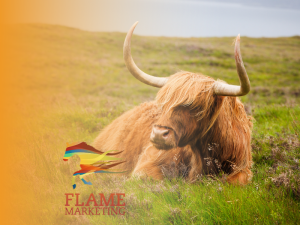

Beef prices are roaring away, due in part to reduced supply particularly from Ireland, but is there a problem on the horizon for farming sustainability?
A recent Exeter market report from west country auctioneers Kivells, records ‘a blistering trade’ with a heavy weight finished Aberdeen Angus steer at 224p per kilo grossing £1,613. The same week, Melton Mowbray reported a phenomenal trade with pure continental bred prime steers to 271p per kilo and £1833.56 in the lump and heifers to 279p per kilo and £1,610. Sounds good enough!
It has been an interesting period since ‘Lockdown 1’. Key to the beef trade is carcass balance, finding specific outlets for the expensive hind quarter cuts and the cheaper, often more difficult to sell, fore quarter cuts. As restaurants and hospitality venues were forced to close, a large market for the expensive cuts disappeared. Beef mince is a staple in the British shopping basket. In the first month of lockdown, 46% of households purchased mince, a significant increase on 36% a year earlier. In the last week of March 66% of primary beef sales were as mince, dragging beef prices to their lowest level of the year (Agricultural and Horticultural Development Board). It was very pleasing, and a little surprising, that steak promotions and adapting some cutting techniques revived the trade so quickly.
If you dig down deeper, there are a lot of ifs and buts.
Selling prime cattle at prices greater than £1,500 sounds great. That price level then feeds down the system. 60% of our beef comes from the dairy herd, pure bred dairy bull calves and bulls and heifers from cows served with either a native or continental beef breed bull. This is the starting point of beef production, and the price of calves reflects the finished price levels. You are starting out with a bull calf at £300 or more and you are feeding it for up to two years and six months. You may sell it to another rearer at 12 months and possibly to a finisher at 24 months. At each level incurring costs and each party wanting a margin, without knowing what level the trade will be in 30 months’ time.
 The biggest threat to any profitability in the beef sector is the reduction and eventual disappearance of the Basic Payment Scheme.
The biggest threat to any profitability in the beef sector is the reduction and eventual disappearance of the Basic Payment Scheme.
Beef is probably one of the riskiest sectors without the BPS. A useful read is the HSBC Forward Planning 2021 Publication which has some costings and gross margins for various crops and livestock systems. The current edition includes financials for a Spring Calving Single Suckler Herd and a Finishing Store Cattle on a 300-380 day feeding system. In both cases, when any direct support payments are not included, they produce a negative margin.
Something to consider; during a recent presentation by the CEO of the National Beef Association to the Guild of Agricultural Journalists, Neil Shand commented that we currently import 400,000 tonnes of beef. To replace these imports, we would need an extra 1.4m suckler cows, which is equivalent to the size of the current beef breeding herd in England, Scotland, and Wales collectively.
Calf sales can be a significant income for a dairy farmer. Since 2018, but sadly halted due to Covid-19 restrictions, FOLK2FOLK have awarded a weekly ‘Champion Calf’ award in Holsworthy Market to encourage dairy farmers to improve the presentation of their calves. This has been hugely successful. Last month was ‘Great British Beef Week’ a wonderful initiative by Ladies in Beef, instigated by West Country farmer Jilly Greed and our current NFU National President Minette Batters.
As always, don’t forget you can show your support through your shopping basket!!
For more information about marketing for your farm diversification business please check out our website: FLAME MARKETING
Article taken from Farming UK